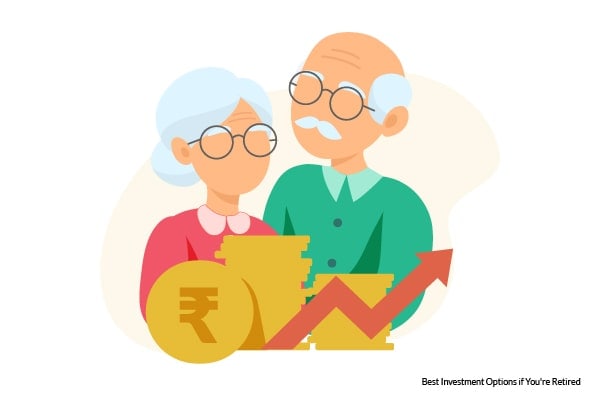Best Investment Options if You're Retired

The end is the beginning of the uncharted, but what about moments before the end? In your 20s, raw energies are bursting with excitement at the prospect of exploring a new world. The infamous 30s usher feelings of apprehension and fear of the inevitable ageing, but you might have already conquered your world. Or are about to! Your 40s are more than just greying hair and aching joints – it’s the point of your prime years.
Before you know it, the 50s come hurtling with a blinding realisation that retirement years are nearly here. And, shortly, they will have arrived. But, will you be ready to welcome their arrival? Or, would your finances be able to manage the expenses these silver years have brought along with them?
Without adequate preparation, your finances could topple under high medical expenses and sudden hospitalisations. But, before you try to counter with the “no family history of illness” excuse, there are other expenses to account for in advance. Some of these include your children’s education, their wedding, etc.
Back to the family medical history bit, it’s not a foolproof measure of health risks. Certain unforeseeable illnesses could befall you, or accidents could throw your health for a toss. After all, even recovering from a minor fall could do more damage than it did in your 20s.
Investment Instruments for Your Silver Years
It goes without saying that saving for these vulnerable years is vital for you and your finances. Lack of retirement funds could put a dent in your savings, depleting years of hard work and restraint. However, there are a few ways to ensure that’s not the case for you. Instead of stowing away chunks of your savings in a moderately high-interest savings account, consider investing it!
Envisage the timelines of all upcoming or foreseeable financial obligations you might encounter. Based on their chronological occurrence, invest in schemes that mature around that period. Moreover, some investment strategies could help you earn a sizeable profit even after investing for a short period.
Investors can search the internet and its forums for self-research on these topics or avail the guidance and expertise of financial advisors. Here are a few top investment instruments that could provide a reasonable income during your silver years.
Fixed Deposits
If you haven’t explored the fruitful world of investments before or prefer low-risk returns, fixed deposits check all those boxes. They’re a secure way of earning safe and predictable returns. While the returns are on the lower spectrum of what investments can fetch, investors can ensure their savings remain free from market volatility. This trade-off could greatly benefit them in the long run.
Moreover, there are various fixed deposits that offer decent interest rates on deposits for long tenures. The senior citizen fixed deposits are a viable solution for individuals over the age of 60 years. This type of fixed deposit offers a higher interest rate, unlike regular fixed deposits. And they come with additional benefits like tax deductions and exemptions.
Conservative Funds
Another way to slowly ease yourself into the investment pool is to opt for conservative funds. As the name suggests, these are funds with an asset allocation of 85-90% debt and 5-10% of equity funds. Despite being on the moderate risk side of the spectrum, they offer higher returns. Since they have a mix of debt and equity funds, the latter allows investors to reap greater returns in exchange.
Furthermore, conservative funds are well-suited for low-risk tolerance investors with long-term financial goals.
Equity Linked Savings Scheme (ELSS)
One of the best ways to save early for retirement is by investing in ELSS. They’re a type of mutual fund that offer considerable returns within a short duration. Additionally, ELSS offer investors tax deductions on the deposited amount. Young low-risk investors and retired individuals can use ELSS to diversify their investments by choosing a small equity exposure.
Also, these funds come with a mandatory 3-year lock-in period. Investors can use this as an opportunity to consistently invest in the fund to build healthy financial habits.
Senior Citizen Saving Scheme (SCSS)
An alternative to fixed deposits is SCSS, they’re ideal for investors who prefer fixed interest rates over floating rates to avoid inflation. As an investment instrument, it allows individuals to accumulate wealth over a period while ensuring it multiplies with the power of compounded interest. In April 2022, interest rates for SCSS were set at 7.4%, which ranks it higher than most fixed deposits in the market.
Investors of this scheme are eligible for tax deductions under Section 80C of the Income Tax Act, 1961. Here, they can claim deductions on the amount deposited into the scheme. The minimum amount that can be invested is ₹1,000. However, partners can jointly invest in this scheme via a joint account.
National Savings Certificate (NSC)
For investors that started their investment journey towards the end of their active earning years, it’s advisable to create a diverse portfolio. One of the schemes best suited for low to moderate earnings is NSC, a form of post-office-based savings scheme. It comes with the seal of government approval for additional assurance and security. Investors can purchase NSCs at any post office in multiple of ₹100 per month for five years. And the minimum contribution allowed is ₹100.
Unlike other traditional investment instruments, NSCs offer attractive interest rates of 8.1% or more. Though, these rates are subject to fluctuations.
While financial experts recommend beginning your investment journey at the start of your career, it’s not a necessity. The point is to invest at all and reap the benefits of compounding interest. Though, it’s important to note that the earlier stages of your life allow more leeway for investment in high-risk equities.
If you haven’t started investing yet, today is a good time as any other! Visit Bajaj MARKETS to experience a seamless investment journey.
